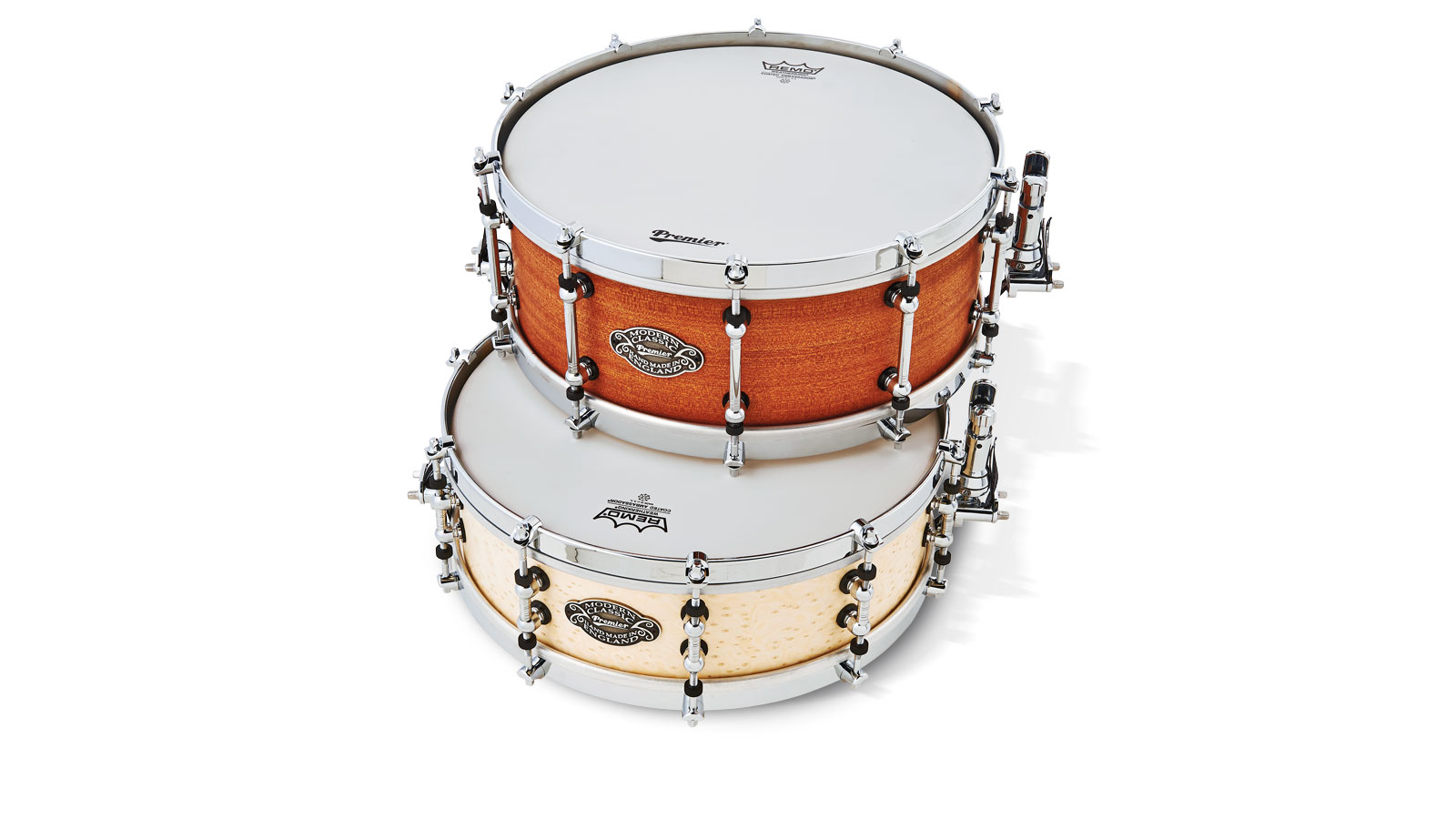MusicRadar Verdict
Combining birch and mahogany in cutting-edge shell craftsmanship with classic hardware, this Modern Classic snare is faultlessly constructed with top quality components throughout.
Pros
- +
Well-crafted, faultless construction. Distinctive, dark yet lively sound.
Cons
- -
Just the prices!
MusicRadar's got your back
We were bowled over by the Modern Classic Kit, the fruit of the first collaboration between Premier's master builder Keith Keough and top endorser Steve White. Now here we have a 14"x51⁄2" in the natural Mahogany finish and a 14"x41⁄2" in the Birdseye Maple veneer.
Build
As with the kit drums, the shell is made from a combination of Grade A Finnish birch and African mahogany. The kit toms are 8-ply and 4.5mm thick, the bass drums 11-ply yet just 6mm thick, while this snare is slightly thicker at 7.6mm.
"Those 5mm-thick flat hoops, while offering the least barrier between head and shell resonance, also keep the drum focused and popping"
What's amazing again is the number of plies - 14 cross-plies of wafer-thin leaves of alternating wood, horizontal and vertical. This is the 'modern' bit of the build. With so many plies you wonder if there's too much glue, stifling the shell resonance. But Keough says quite the contrary, "The glues we use are so hard, it's the wood dampening the glue!"
In fact Keith claims that having made every type of shell - ply, solid, stave and even hollowed-out trunks - these are the most resonant of all. All those plies certainly hold the shell in round, which like the toms and bass drums are phenomenally accurate. Perfectly circular by our measurements, and we can't stress enough how rare that is.
The bearing edges are a shallow 30° and rounded over, though not quite as much as those on the toms and kicks. The edges are sanded smooth, oiled and wax-coated. Snare beds are 2mm deep and sanded flat, not rounded.
Keith says, "This type of flat bed worked best, controlling the snares better and helping eliminate the buzz."
Also helping snare control is the top quality Dunnett R7C three-position throw-off, which cleverly hinges through 180° so the on-off lever can pull left, right or centrally.
Want all the hottest music and gear news, reviews, deals, features and more, direct to your inbox? Sign up here.
As with the kit drums again, what strikes you most visually are the rolled steel, flat band hoops. At 5mm they are much thicker than normal 2.3mm die-cast hoops and are kind to your sticks. Adding to the classic vibe are 10 double-ended solid brass tube lugs and chromed-bronze claw-clips.
Hands On
The shell is exceptionally resonant, which results in lively ringing as you play nearer the edge, equally noticeable on rim-shots and cross-sticks. But strike in the centre and there's a rather curt, decidedly dark response, a vintage sound resulting we think from the rounded bearing edges.
The head sits largely on the four central, vertical innermost plies, which give a deeper and thicker tone. To balance that tendency we tightened both the resonant head and the snare wires a fraction above what we normally like. Then, with the batter crisp (sic) the centre spot came more alive.
It seems those 5mm-thick flat hoops, while offering the least barrier between head and shell resonance, somehow also keep the drum focused and popping. The 14"x41⁄2" drum is so sharp it was actually touching pain threshold when we just tapped away lightly. This is a funky drum that will have you ripping out snappy beats in any style.
The 14"x51⁄2" is the more obvious all-rounder. We took this one on a couple of quite different gigs where the sensitivity of the drum shone through, but we found it almost too dense. It seems churlish to describe a drum as having too much substance where so many others are weedy and clattery, but there it is.
Because there are 10 chromed-bronze claw clips they are closely spaced and it is quite easy to catch one if you play rim shots. It's really a matter of getting used to the layout and it's a good test of your accuracy and consistency.

Geoff Nicholls is a musician, journalist, author and lecturer based in London. He co-wrote, co-presented and played drums on both series of ‘Rockschool’ for BBC2 in the 1980s. Before that he was a member of original bands signed by Decca, RCA, EMI and more. ‘Rockschool’ led to a parallel career writing articles for many publications, from the Guardian to Mojo, but most notably Rhythm magazine, for which he was the longest serving and most diverse contributor.
